Effects of Crystal Orientation and External Stress on the Static Recrystallization Behavior of an Ni-Based Single-Crystal Superalloy
Abstract
:1. Introduction
2. Materials and Experimental Procedures
3. Results and Discussion
3.1. Effects of Crystal Orientation on Recrystallization Behavior
3.1.1. As-Cast Dendrite Morphology and Microstructure Characteristics
3.1.2. Recrystallization Behavior at Different Crystal Orientations
3.1.3. Dislocation Slip Behaviors and Mechanisms in Various Crystal Orientations
- (1)
- Dislocation slip behaviors in various crystal orientations
- (2)
- Dislocation slip mechanisms in various crystal orientations
3.2. Effects of External Stress on Recrystallization Behavior
3.3. Growth Behavior of SRX in Dendrite and Interdendritic Regions
4. Conclusions
- (1)
- The SRX behavior of the DD5 Ni-based SC rod exhibits a correlation with orientation, where the depth of SRX increases with higher β values. In SC superalloys, room temperature deformation is primarily driven by crystal slips. The activation of slip systems is dependent on crystal orientation, leading to the activation of different slip systems based on the β value.
- (2)
- Load on sample affects the depth of SRX, with higher loads resulting in deeper SRX layers.
- (3)
- Variations in element distribution and the size disparity of the γ′ phase result in the formation of γ/γ′ eutectics and larger γ′ phases in DD5 castings. Residual γ/γ′ eutectics and coarse γ′ phases serve as impediments to the growth of SRX during heat treatment, thereby impeding the migration of SRX grain boundaries.
- (4)
- By optimizing the spiral crystal selection process or utilizing seed crystal technology to acquire SC castings with a smaller crystal orientation, and preventing local deformation caused by collisions during the removal of shells of SC castings, the occurrence of SRX in SC superalloys can be effectively controlled.
Author Contributions
Funding
Institutional Review Board Statement
Informed Consent Statement
Data Availability Statement
Conflicts of Interest
References
- Huang, K.; Marthinsen, K.; Zhao, Q.; Logé, R.E. The double-edge effect of second-phase particles on the recrystallization behaviour and associated mechanical properties of metallic materials. J. Mater. Sci. 2018, 92, 284–359. [Google Scholar] [CrossRef]
- Momeni, A.; Abbasi, S.M.; Morakabati, M.; Badri, H. A comparative study on the hot working behavior of Inconel 718 and ALLVAC 718 plus. J. Metall. Mater. Trans. A 2017, 48, 1216–1229. [Google Scholar] [CrossRef]
- Luo, L.; Ru, Y.; Qin, L.; Pei, Y.; Ma, Y.; Li, S.S.; Zhao, X.B.; Gong, S.K. Effects of alloyed aluminum and tantalum on the topological inversion behavior of Ni-based single crystal superalloys at high temperature. J. Adv. Eng. Mater. 2019, 21, 1800793. [Google Scholar] [CrossRef]
- Wang, R.N.; Xu, Q.Y.; Su, X.L.; Li, Z.L.; Liu, B.C. Influence of gibbosity on recrystallization behavior of single crystal blade casting. J. Mater. Process. Technol. 2018, 259, 169–179. [Google Scholar] [CrossRef]
- Xia, W.S.; Zhao, X.B.; Yue, L.; Zhang, Z. Microstructural evolution and creep mechanisms in Ni-based single crystal superalloys: A review. J. Alloys Compd. 2020, 819, 152954. [Google Scholar] [CrossRef]
- Hamadi, S.; Hamon, F.; Delautre, J.; Cormier, J.; Villechaise, P.; Utada, S.; Kontis, P.; Bozzolo, N. Consequences of a room-temperature plastic deformation during processing on creep durability of a Ni-based SX superalloy. J. Metall. Mater. Trans. A 2018, 49, 4246–4261. [Google Scholar] [CrossRef]
- Nasab, M.H.; Serajzadeh, S. Thermal stresses and kinetics of phase transformation on the run-out table after hot strip rolling of low-carbon steels. Int. J. Adv. Manuf. Technol. 2016, 83, 1725–1736. [Google Scholar] [CrossRef]
- Salehi, M.S.; Serajzadeh, S. Simulation of static recrystallization in non-isothermal annealing using a coupled cellular automata and finite element model. J. Comput. Mater. Sci. 2012, 53, 145–152. [Google Scholar] [CrossRef]
- Utada, S.; Rame, J.; Hamadi, S.; Delautre, J.; Villechaise, P.; Cormier, J. Kinetics of creep damage accumulation induced by a room-temperature plastic deformation introduced during processing of AM1 Ni-based single crystal superalloy. J. Mater. Sci. Eng. A 2020, 789, 139571. [Google Scholar] [CrossRef]
- Panwisawas, C.; Mathur, H.; Gebelin, J.C.; Putman, D.; Rae, C.M.; Reed, R.C. Prediction of recrystallization in investment cast single-crystal superalloys. J. Acta. Mater. 2013, 61, 51–66. [Google Scholar] [CrossRef]
- Liu, F.; Guo, X.; Yang, G. Recrystallization mechanism for the grain refinement in undercooled DD3 single-crystal superalloy. J. Cryst. Growth. 2000, 219, 489–494. [Google Scholar] [CrossRef]
- Mathur, H.N.; Panwisawas, C.; Jones, C.N.; Reed, R.C.; Rae, C.M. Nucleation of recrystallisation in castings of single crystal Ni-based superalloys. J. Acta. Mater. 2017, 129, 112–123. [Google Scholar] [CrossRef]
- Zhang, J.; Wang, L.; Wang, D.; Xie, G.; LU, Y.; Shen, J.; Lou, L. Recent progress in research and development of nickel-based single crystal superalloys. J. Acta Metall Sin. 2019, 55, 1077–1094. [Google Scholar]
- Chen, S.L.; Jiang, W.J.; Du, J. Research Progress of Surface-recrystallization control technology of Ni-based single-Crystal Superalloy. J. Chongqing Univ. 2020, 43, 74–79. [Google Scholar]
- Pan, H.; Liu, W.; Wang, H.; Liu, Y.G.; Tian, Y.Q.; Chen, K.; Shen, X.H.; Zhan, H.; Mao, X.Y.; Xiao, Y.Y.; et al. Understanding crystallographic orientation, microstructure and mechanical properties dependent interaction between recrystallization and phase transformation of a Fe–Al–Mn–Mo–C dual-phase steel. J. Mater. Res. Technol. 2021, 15, 6190–6203. [Google Scholar] [CrossRef]
- Momeni, A.; Abbasi, S.M.; Morakabati, M.S.M. Ghazi Mirsaed. Flow softening behavior of Ti–13V–11Cr–3Al beta Ti alloy in double-hit hot compression tests. J. Mater. Res. 2016, 31, 3900–3906. [Google Scholar] [CrossRef]
- Doğu, M.N.; Davut, K.; Obeidi, M.A.; Yalçın, M.A.; Gu, H.F.; Low, T.S.E.; Ginn, J.; Brabazon, D. Recrystallization and grain growth kinetics of IN718 manufactured by laser powder bed fusion. J. Mater. Res. Technol. 2022, 19, 4242–4257. [Google Scholar] [CrossRef]
- Cox, D.C.; Roebuck, B.; Rae, C.M.F.; Reed, R.C. Recrystallisation of single crystal superalloy CMSX-4. Mater. Sci. Technol. 2003, 19, 440–446. [Google Scholar] [CrossRef]
- Xie, G.; Wang, L.; Zhang, J.; Lou, L.H. Orientational dependence of recrystallization in an Ni-base single-crystal superalloy. J. Scripta. Mater. 2012, 66, 378–381. [Google Scholar] [CrossRef]
- Zhang, B.; Liu, D. Influence of recrystallization on high-temperature stress rupture property and fracture behavior of single crystal superalloy. J. Mat. Sci. Eng. A 2012, 551, 149–153. [Google Scholar] [CrossRef]
- Wang, L.; Xie, G.; Lou, L.H. Effect of carbon content on the recrystallization of a single crystal nickel-based superalloy. J. Mater Lett. 2013, 109, 154–157. [Google Scholar] [CrossRef]
- Paul, U.; Sahm, P.R.; Goldschmidt, D. Inhomogeneities in single-crystal components. Mater. Sci. Eng. A Struct. Mater. Prop. Microstruct. Process. 1993, 49, e54. [Google Scholar] [CrossRef]
- Shi, Z.X.; Liu, S.Z.; Wang, X.G.; Li, J.R. Effects of Heat Treatment on Surface Recrystallization and Stress Rupture Properties of a Fourth-Generation Single-Crystal Superalloy after Grit Blasting. J. Acta Metal Sin. 2017, 30, 614–620. [Google Scholar] [CrossRef]
- Bürgel, R.; Portella, P.D.; Preuhs, J. Recrystallization in single crystals of nickel base superalloys. J. Superalloys 2000, 229–238. [Google Scholar] [CrossRef]
- Li, Z.L.; Xu, Q.Y.; Liu, B. Experimental investigation on recrystallization mechanism of a Ni-base single crystal superalloy. J. Alloy. Compd. 2016, 672, 457–469. [Google Scholar] [CrossRef]
- Zambaldi, C.; Roters, F.; Raabe, D.; Glatzel, U. Modeling and experiments on the indentation deformation and recrystallization of a single-crystal nickel-base superalloy. J. Mater. Sci. Eng. A 2007, 454, 433–440. [Google Scholar] [CrossRef]
- Xu, F.Z.; Lin, Y.C.; Ma, D.X.; Zhao, Y.X.; He, D.G.; Liu, G. Investigation on recrystallization of single crystal superalloy CMSX-4 casting. J. Mater. Eng. 2023, 51, 42–50. [Google Scholar]
- Wang, Q.; Hu, B.; Zhao, H.G.; Ru, Y.; Qu, W.W.; Pei, Y.L.; Li, S.S.; Gong, S.K. Evolution of static recrystallization microstructure caused by residual strain of an Al-richen Ni-based single crystal superalloy. J. Mat. Sci. Eng. A 2024, 894, 146188. [Google Scholar] [CrossRef]
- Pu, S.; Xie, G.; Wang, L.; Pan, Z.Y.; Lou, L.H. Effect of Re and W on deformation and recrystallization of solid solution heat treated Ni-base single crystal superalloy. J. Acta Metall. Sin. 2015, 51, 239–248. [Google Scholar]
- Wang, L.; Xie, G.; Zhang, J.; Lou, L.H. On the role of carbides during the recrystallization of a directionally solidified nickel-base superalloy. J. Scripta. Mater. 2006, 55, 457–460. [Google Scholar] [CrossRef]
- Shi, Z.X.; Yue, X.D.; Wang, Z.C. Effects of Re content on the microstructure and tensile properties of a single crystal superalloy. J. Nonfer. Met. Sci. Eng. 2020, 11, 113–118. [Google Scholar]
- Tian, L.; Xu, C.; Ma, C. Recrystallization of a single crystal Ni-base superalloy in <011> and <111> orientations. J. Mater. Charact. 2017, 127, 116–120. [Google Scholar]
- Shi, Z.X.; Liu, S.Z.; Zhao, J.Q.; Wang, X.; Li, J. Effect of crystal orientation on high cycle fatigue properties of fourth generation single crystal superalloy DD15. J. Aero. Manufact. Technol. 2021, 64, 51–56,61. [Google Scholar]
- Yang, C.B.; Liu, L.; Zhao, X.B.; Liu, G.; Zhang, J.; Fu, H.Z. Dendrite arm spacing and microsegregation in <001> and <011> orientation single crystal superalloys DD407. J. Acta Metall. Sin. 2011, 47, 1246–1250. [Google Scholar]
- Wang, H.B.; Li, X.H.; Shang, Y.; Zhang, S.Q.; Hu, B.; Pei, Y.L.; Li, S.S.; Gong, S.K. The secondary orientation effect of single crystal superalloy thin-wall specimens at 850 °C with [001] primary orientation. J. Mater. Res. Technol. 2024, 29, 3205–3216. [Google Scholar] [CrossRef]
- Han, Q.N.; Rui, S.S.; Qiu, W.; Su, Y.; Ma, X.; Su, Z.M.; Cui, H.T.; Shi, H.J. Effect of crystal orientation on the indentation behaviour of Ni-based single crystal superalloy. J. Mater. Sci. Eng. A 2020, 773, 138893. [Google Scholar] [CrossRef]
- Gudivada, G.; Pandey, A.K. Recent developments in nickel-based superalloys for gas turbine applications: Review. J. Alloy. Compd. 2023, 963, 171128. [Google Scholar] [CrossRef]
- Gao, X.Y.; Zhang, Z.; Liu, L.Y.; Tao, C.H. Lattice Rotation and Deformation Mechanisms under Tensile Loading in a Single-Crystal Superalloy with [001]. J. Misorientation Mater. 2024, 17, 1368. [Google Scholar] [CrossRef] [PubMed]
- Qin, L.; Pei, Y.; Li, S.; Gong, S.; Xu, H. Influence of stress and secondary orientation on the oxidation-induced dynamic recrystallization behavior of a Ni-based single crystal superalloy. J. Alloy. Compd. 2017, 706, 455–460. [Google Scholar] [CrossRef]
- Jiao, B.Q.; Zhao, Q.Y.; Zhao, Y.Q.; Zhang, W.W.; Zhang, W.; Hu, Z.W.; Gao, X.Q.; Li, Y.C.; Cui, C.X.; Tian, X. New insights into the recrystallization behavior of large-size Mo–3Nb single crystal based on multi-scale characterization. J. Mater. Res. Technol. 2022, 20, 303–319. [Google Scholar] [CrossRef]
- Wei, D.H.; Zhang, W.J.; Huang, H.Y.; Zhang, L.P.; Chen, R.Y.; Wu, Y.W.; Shi, H.J.; Ma, X.F. Effect of crystal orientation on cyclic plastic behaviors of partially recrystallized single crystal nickel-based superalloy. IOP Conf. Ser. Mat. Sci. Eng. 2019, 538, 012004. [Google Scholar] [CrossRef]
- Qin, J.R.; Yang, W.C.; Wang, Q.; Zhou, Y.H.; Fu, H.T.; Zhang, J.; Liu, L. Orientation control of multiple single crystal blades using a novel high-throughput mold via seeding-grain selection technique. J. Mater. Res. Technol. 2024, 29, 4845–4853. [Google Scholar] [CrossRef]
- Cheng, T.; Wang, Y.; Zhao, Y.; Lv, L.; Hu, Q.; Ma, D. Effect of remelting solution heat treatment on microstructure evolution of nickel-based single crystal superalloy DD5. J. Mater. Charact. 2022, 192, 112186. [Google Scholar] [CrossRef]
- Yong, S.; Sugui, T.; Huichen, Y.; Delong, S.; Shuang, L. Microstructure evolution and its effect on creep behavior of single crystal Ni-based superalloys with various orientations. J. Mater. Sci. Eng. A 2016, 668, 243–254. [Google Scholar] [CrossRef]
- Hielscher, R. MTEX 5.10.1, 9/2023. Available online: https://mtex-toolbox.github.io/ (accessed on 17 June 2024).
- Li, P.; Yao, W.X.; Jiang, W.; Han, Q.; Huang, J. Orientation-dependent low cycle fatigue performance of nickel-base single crystal superalloy at intermediate temperature range. J. Mater. Today Commun. 2021, 26, 101836. [Google Scholar] [CrossRef]
- Tian, L.X.; Chen, J.; Xiao, W.L.; Ma, C.L. Orientational dependence of microstructure evolution and the related deformation mechanism of a single crystal Ni-base superalloy. J. Mater. Sci. Eng. A 2017, 684, 115–119. [Google Scholar] [CrossRef]
- Sass, V.; Glatzel, U.M. Feller-Kniepmeier. Anisotropic creep properties of the nickel-base superalloy CMSX-4. J. Acta. Mater. 1996, 44, 1967–1977. [Google Scholar] [CrossRef]
- Westbrooke, E.F.; Forero, L.E.; Ebrahimi, F. Slip analysis in a Ni-base superalloy. J. Acta. Mater. 2005, 53, 2137–2147. [Google Scholar] [CrossRef]
- Matan, N.; Cox, D.C.; Carter, P.; Rist, M.A.; Rae, C.M.F.; Reed, R.C. Creep of CMSX-4 superalloy single crystals: Effects of misorientation and temperature. J. Acta. Mater. 1999, 47, 1549–1563. [Google Scholar] [CrossRef]
- Wang, G.; Zhang, S.; Tian, S.; Tian, N.; Zhao, G.; Yan, H. Microstructure evolution and deformation mechanism of a [111]-oriented nickel-based single-crystal superalloy during high-temperature creep. J. Mater. Res. Technol. 2022, 16, 495–504. [Google Scholar] [CrossRef]
- Bettge, D.; Österle, W. “Cube slip” in near [111] oriented specimens of a single-crystal nickel-base superalloy. J. Scripta. Mater. 1999, 40, 389–395. [Google Scholar] [CrossRef]
- Wang, L.N.; Liu, Y.; Yu, J.J.; Xu, Y.; Sun, X.F.; Guan, H.R.; Hu, Z.Q. Orientation and temperature dependence of yielding and deformation behavior of a nickel-base single crystal superalloy. J. Mater. Sci. Eng. A 2009, 505, 144–150. [Google Scholar] [CrossRef]
- Yan, W.Z.; Li, Y.L.; Wen, Z.X.; Zou, S.H.; Duan, Z.H. Effect of crystallographic orientation on nano-indentation behavior of nickel based single crystal super alloys. J. Rare. Metal. Mat. Eng. 2020, 49, 1854–1859. [Google Scholar]
- Wu, X.; Zhang, J.H.; Liu, J.L.; Jin, T.; Xu, Y.B.; Hu, Z.Q. Plastic deformation inhomogeneity in a single crystal nickel-base superalloy. J. Mater. Sci. Eng. A 2002, 325, 478–483. [Google Scholar] [CrossRef]
- Hill, R.; Rice, J.R. Constitutive analysis of elastic-plastic crystals at arbitrary strain. J. Mech. Phys. Solids 1972, 20, 401–413. [Google Scholar] [CrossRef]
- Asaro, R.J.; Rice, J.R. Strain localization in ductile single crystals. J. Mech. Phys. 1977, 25, 309–338. [Google Scholar] [CrossRef]
- Asaro, R.J. Micromechanics of crystals and polycrystals. J. Adv. Appl. Mech. 1983, 23, 1–115. [Google Scholar]
- Peirce, D.; Asaro, R.J.; Needleman, A. Material rate dependence and localized deformation in crystalline solids. J. Acta Metall. 1983, 31, 1951–1976. [Google Scholar] [CrossRef]
- Huang, Y. A User-Material Subroutine Incorporating Single Crystal Plasticity in the Abaqus Finite Element Program; Harvard University: Cambridge, UK, 1991. [Google Scholar]
- Wang, Y.; Raabe, D.; Klüber, C.; Roters, F. Orientation dependence of nanoindentation pile-up patterns and of nanoindentation microtextures in copper single crystals. J. Acta. Mater. 2004, 52, 2229–2238. [Google Scholar] [CrossRef]
- Xiang, S.S. Study of Secondary γ′ Precipitats and Cabides of a Second Generation Single Crystal Superalloy. Ph.D. Thesis, Beijing University of Technology, Beijing, China, 2017. [Google Scholar]
- Humphreys, F.J.; Hatherly, M. Recrystallization and Related Annealing Phenomena, 2nd ed.; Pergamon Press: Oxford, UK, 2004. [Google Scholar]
- Wang, L.; Jiang, W.G.; Lou, L.H. The deformation and the recrystallization initiation in the dendrite core and interdendritic regions of a directionally solidified nickel-based superalloy. J. Alloy. Compd. 2015, 629, 247–254. [Google Scholar] [CrossRef]
- Wang, L.; Pyczak, F.; Zhang, J.; Lou, L.H.; Singer, R.F. Effect of eutectics on plastic deformation and subsequent recrystallization in the single crystal nickel base superalloy CMSX-4. J. Mater. Sci. Eng. A 2012, 532, 487–492. [Google Scholar] [CrossRef]
- Qin, L.; Pei, Y.; Li, S.; Zhao, X.; Gong, S.; Xu, H. Effect of thermal stability of γ′ phase on the recrystallization behaviors of Ni-based single crystal superalloys. J. Mater. Design. 2017, 130, 69–82. [Google Scholar] [CrossRef]
- Kearsey, R.M.; Beddoes, J.C.; Jones, P.; Au, P. Compositional design considerations for microsegregation in single crystal superalloy systems. J. Intermet. 2004, 12, 903–910. [Google Scholar] [CrossRef]
- Cao, K.L.; Yang, W.C.; Zhang, J.C.; Liu, C.; Qu, P.F.; Su, H.J.; Zhang, J.; Liu, L. Solidification characteristics and as-cast microstructures of a Ru-containing nickel-based single crystal superalloy. J. Mater. Res. Technol. 2021, 11, 474–486. [Google Scholar] [CrossRef]
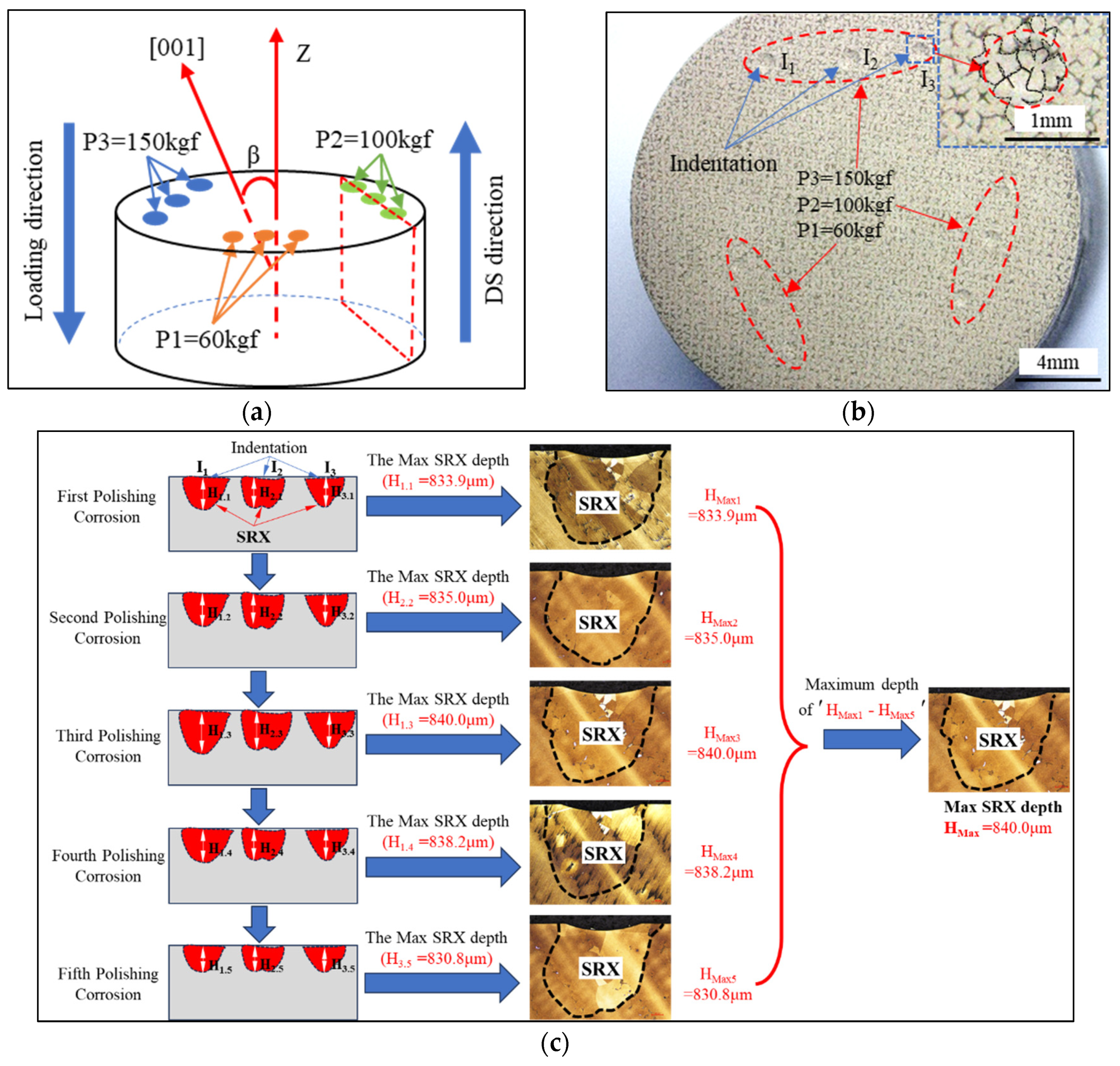
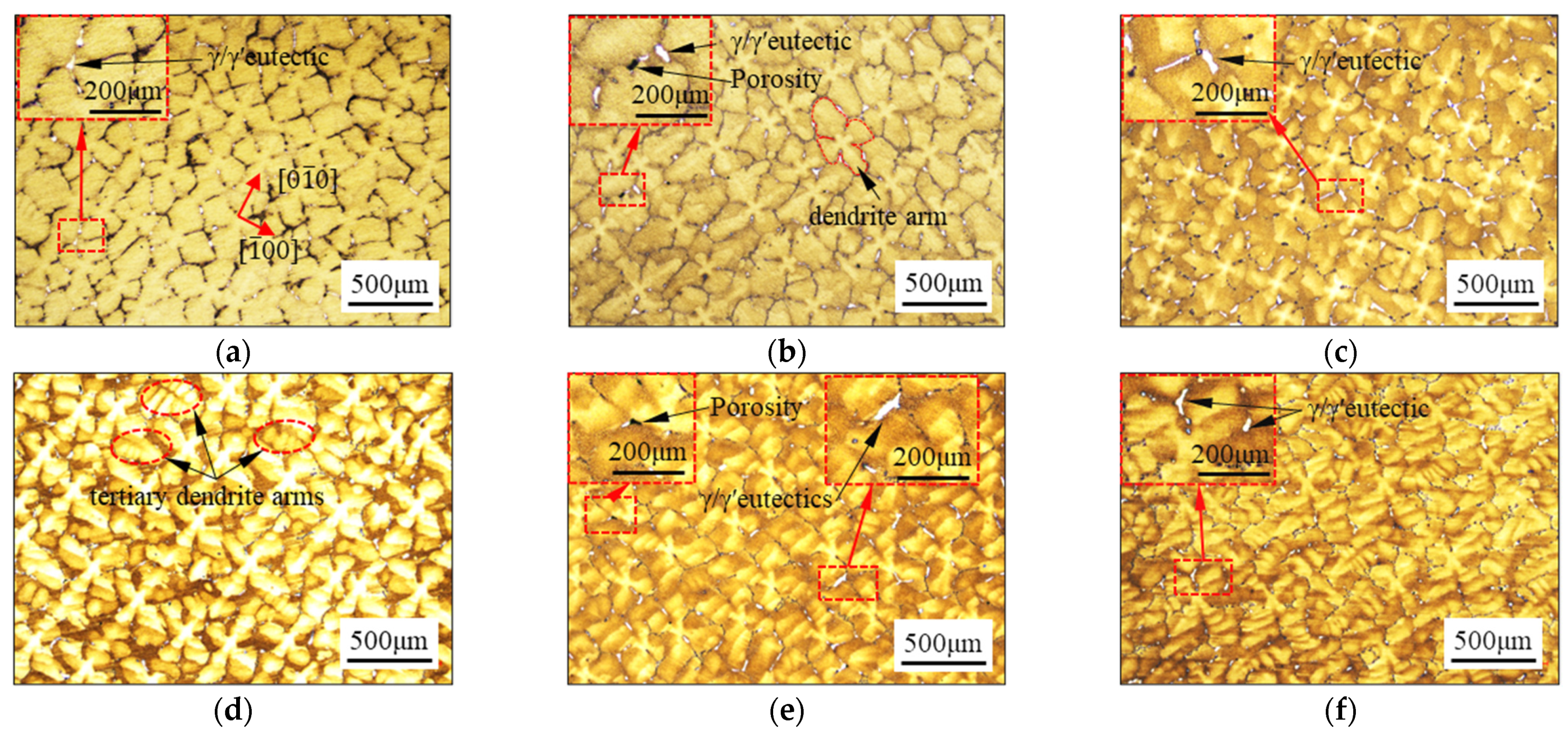
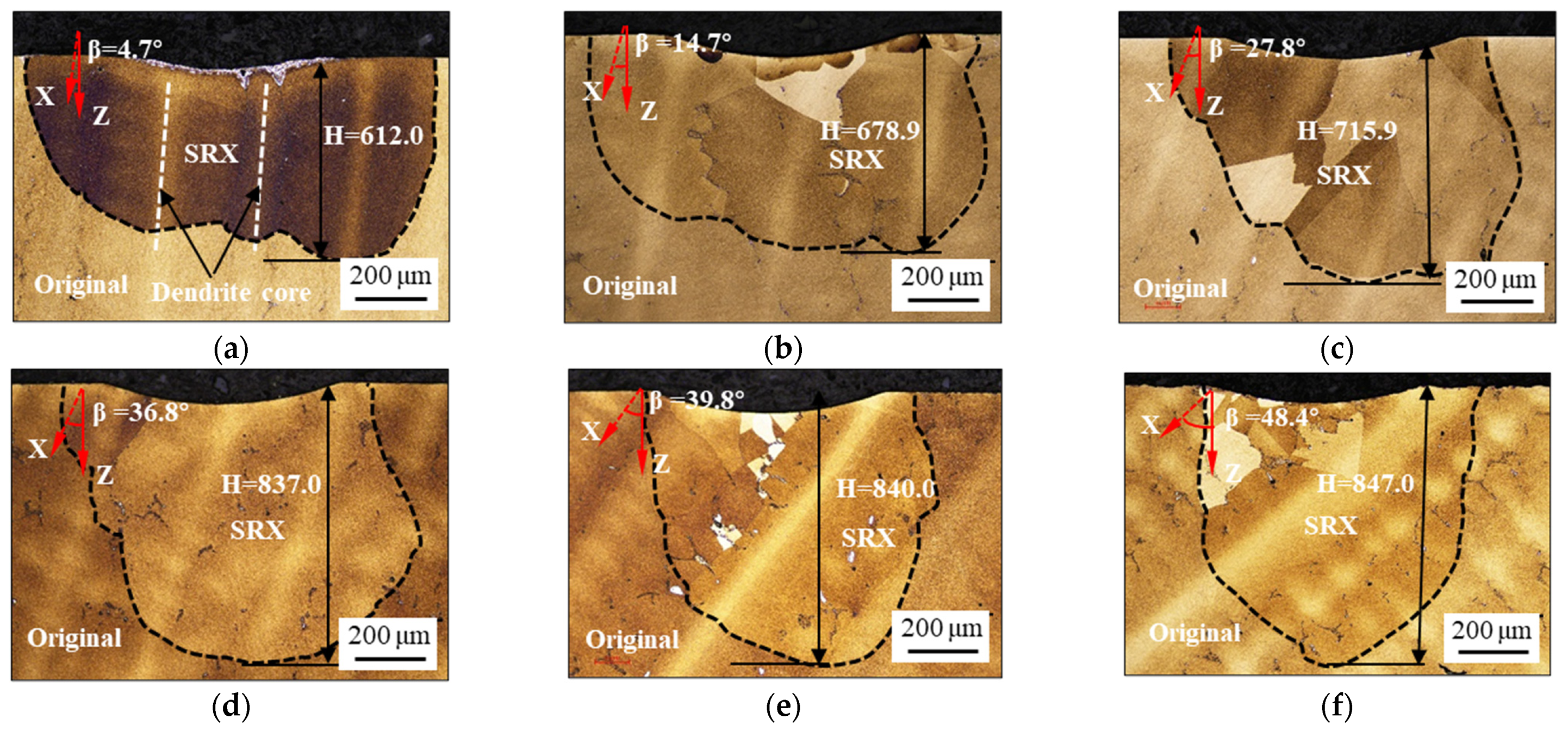
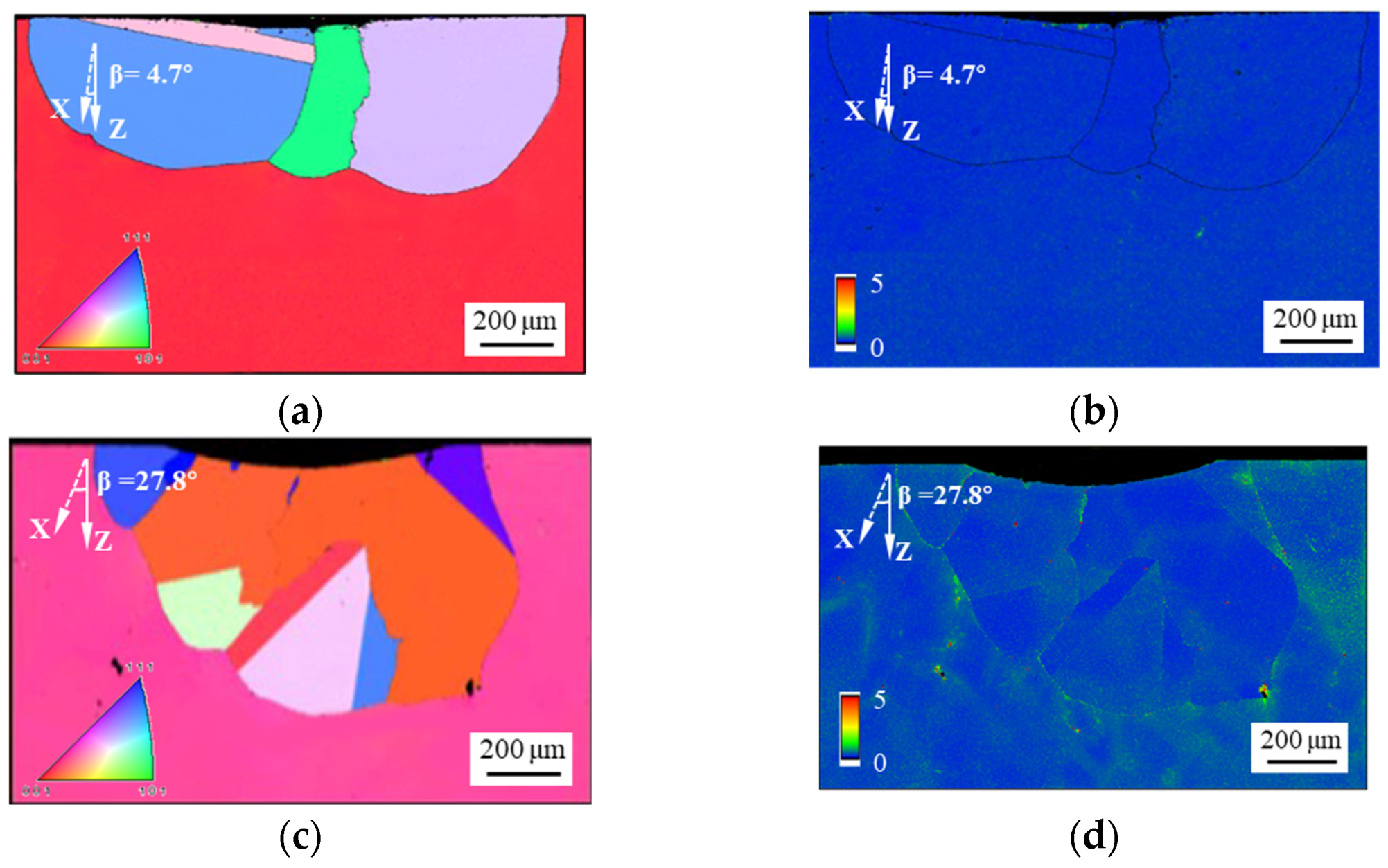






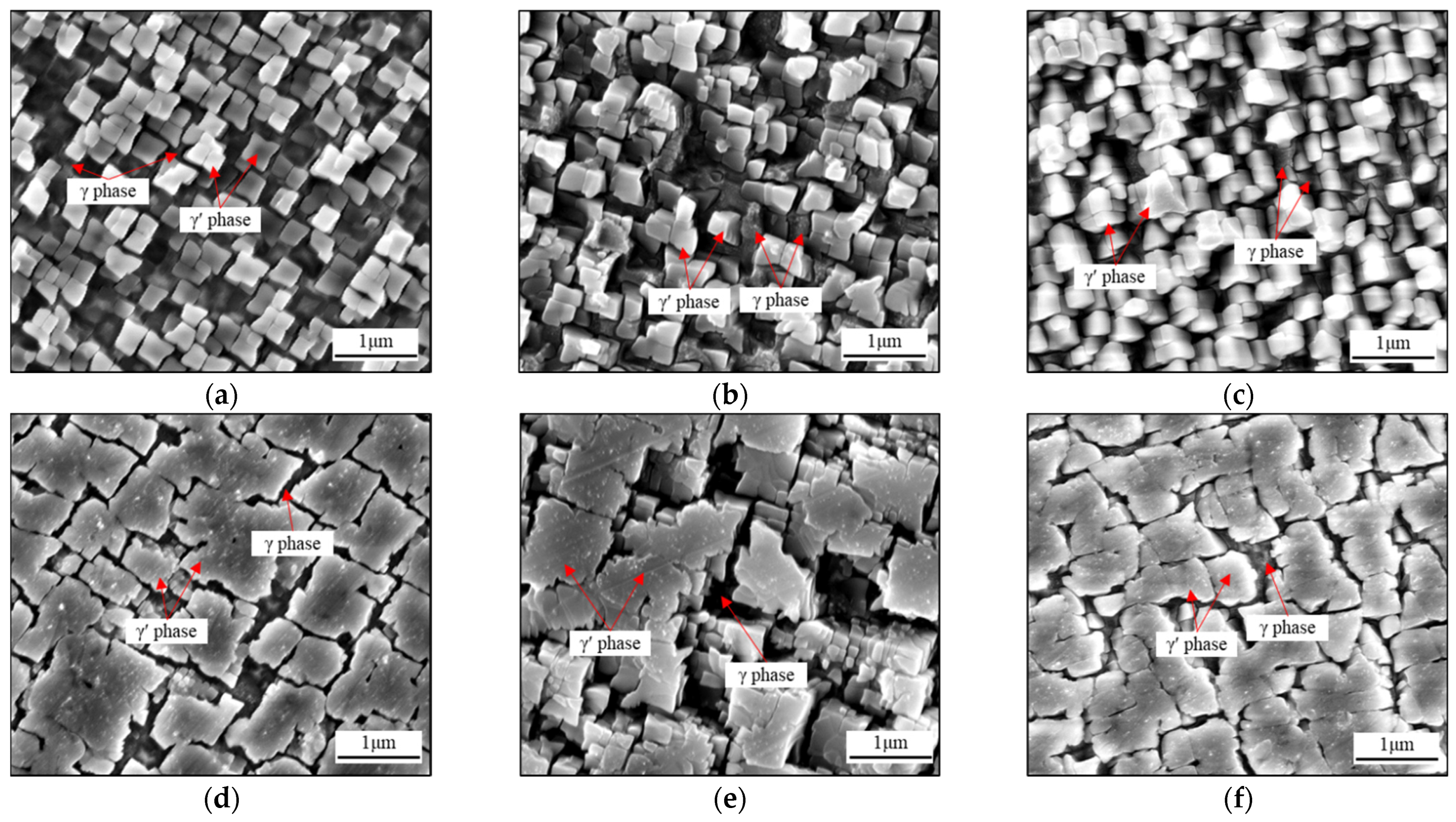
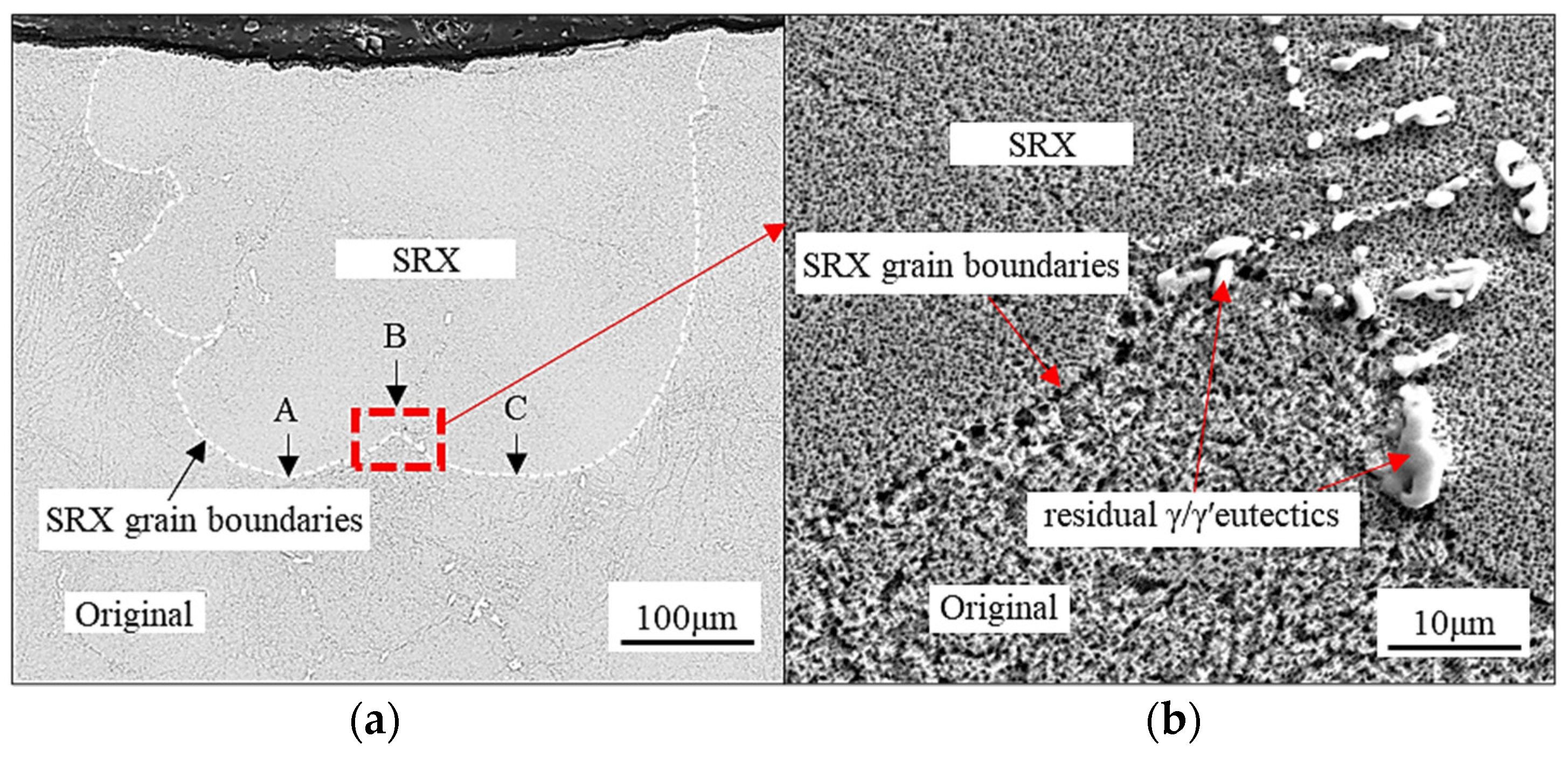
| Element | Cr | Co | W | Mo | Al | Ta | Hf | Re | Ti | Ni |
|---|---|---|---|---|---|---|---|---|---|---|
| wt. (%) | 7.0 | 7.5 | 5.0 | 1.5 | 6.2 | 6.5 | 0.15 | 3.0 | - | Bal. |
| Sample | A | B | C | D | E | F |
|---|---|---|---|---|---|---|
| β (°) | 4.7 | 14.7 | 27.8 | 36.8 | 39.8 | 48.4 |
| Slip Plane | ||||||||||||
| Slip Direction | ||||||||||||
| Slip System No. | ① | ② | ③ | ④ | ⑤ | ⑥ | ⑦ | ⑧ | ⑨ | ⑩ | ⑪ | ⑫ |
| Sample A (4.7°) | 0.39 | 0.38 | 0.01 | 0.43 | 0.39 | 0.04 | 0.42 | 0.38 | 0.03 | 0.41 | 0.43 | 0.02 |
| Sample C (27.8°) | 0.18 | 0.22 | 0.4 | 0.16 | 0.32 | 0.48 | 0.01 | 0.08 | 0.06 | 0.16 | 0.30 | 0.15 |
| Sample F (48.4°) | 0.43 | 0.03 | 0.4 | 0.04 | 0.27 | 0.23 | 0.10 | 0.13 | 0.03 | 0.06 | 0.2 | 0.14 |
| Slip Plane | ||||||
| Slip Direction | ||||||
| Slip System No. | ⑬ | ⑭ | ⑮ | ⑯ | ⑰ | ⑱ |
| Sample F (48.4°) | 0.17 | 0.47 | 0.45 | 0.18 | 0.29 | 0.01 |
Disclaimer/Publisher’s Note: The statements, opinions and data contained in all publications are solely those of the individual author(s) and contributor(s) and not of MDPI and/or the editor(s). MDPI and/or the editor(s) disclaim responsibility for any injury to people or property resulting from any ideas, methods, instructions or products referred to in the content. |
© 2024 by the authors. Licensee MDPI, Basel, Switzerland. This article is an open access article distributed under the terms and conditions of the Creative Commons Attribution (CC BY) license (https://creativecommons.org/licenses/by/4.0/).
Share and Cite
Xu, F.; Lin, Y.; Ma, D.; Xiong, W.; He, D.; Liu, G.; Zhao, Y. Effects of Crystal Orientation and External Stress on the Static Recrystallization Behavior of an Ni-Based Single-Crystal Superalloy. Materials 2024, 17, 3123. https://doi.org/10.3390/ma17133123
Xu F, Lin Y, Ma D, Xiong W, He D, Liu G, Zhao Y. Effects of Crystal Orientation and External Stress on the Static Recrystallization Behavior of an Ni-Based Single-Crystal Superalloy. Materials. 2024; 17(13):3123. https://doi.org/10.3390/ma17133123
Chicago/Turabian StyleXu, Fuze, Yongcheng Lin, Dexin Ma, Wei Xiong, Daoguang He, Guan Liu, and Yunxing Zhao. 2024. "Effects of Crystal Orientation and External Stress on the Static Recrystallization Behavior of an Ni-Based Single-Crystal Superalloy" Materials 17, no. 13: 3123. https://doi.org/10.3390/ma17133123





